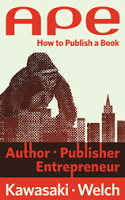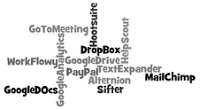Tony Eldridge's Blog, page 4
September 25, 2013
The New Way Authors are Turning Their Books into Movies
Have you ever thought about whether your book should be a movie? It's easier than you think. In this interview Ken Atchity discusses how your book can be turned into a film.
Ken Atchity is the "story merchant" - he's a writer, producer, career coach, teacher, and literary manager, and he's launched dozens of books and films. His life's passion is finding great storytellers and turning them into bestselling authors and screenwriters. You can learn more about Ken at The Story Merchant, http://www.storymerchant.com/.








Published on September 25, 2013 15:10
September 22, 2013
How to Edit Your Book - Method 4: Professionals

This chapter
explains how to transform your self-edited manuscript into a finished
manuscript. A high-quality book requires extensive testing and copyediting. You
can get these processes done without a traditional publisher, but you
cannot eliminate them. Your goal is a book that looks and feels as good as any
book from a big-time, traditional publisher.
For
all the goodness of crowdsourcing, you still need someone to review your
manuscript with a magnifying glass and a professional eye to optimize your
content and to kill virtually every typographical, grammatical, and factual
error.
You
might not need a content editor if you have enough smart, hardcore voluntary
readers, but the probability that you will find every spelling and grammatical
mistake is zero. Word and other word processors may even introduce typos
and grammatical mistakes:
I have
a spelling checker,
It
came with my PC.
It
plane lee marks four my revue
Miss
steaks aye can knot sea.
Eye
ran this poem threw it,
Your
sure reel glad two no.
Its
vary polished in it's weigh.
My
checker tolled me sew.
A
checker is a bless sing,
It
freeze yew lodes of thyme.
It
helps me right awl stiles two reed,
And
aides me when eye rime.
("Candidate
for a Pullet Surprise," http://grammar.about.com/od/spelling/a/spellcheck.htm by
Mark Eckman and Jerold H. Zar. Hat-tip to Bob Soltys for this pointer.)
The
going rate for copyediting is $35 per hour, and copyeditors can work their
magic at the rate of roughly ten pages per hour (although this can vary
depending on the complexity of the material), so you'll pay approximately
$1,000-$1,500 for a three-hundred-page manuscript. This is one of the dumbest
places to try to save money, because poor copyediting destroys the quality of
your book.
One of
the challenges of hiring a copyeditor is figuring out if he or she is any
good-particularly for your first book. Here are four ways to find a good one:
* MCAT.
Rachelle Mandik was the copyeditor for What
the Plus! and APE, and
she put together a test called the Mandik Copyediting Aptitude Test (MCAT).
It's an early version of the preface of APE with Rachelle's corrections. Give copyeditor
candidates the document and compare their corrections to Rachelle's to
determine how good they are. It's not a foolproof instrument, she cautions, but
it's definitely a good place to start, especially for nonfiction. The document
is at APETheBook.com.
* Authors. Ask
authors for their recommendations. This pitch would work on me: "Dear Guy,
I loved your book. May I ask who your editor and copyeditor were? I'd like to
hire them to help me with my book."
* Moonlighters. Many
content editors moonlight as independent consultants, so you may be able to
hire the kind of editor you would have gotten at a traditional publisher anyway.
* Social-media referrals. Ask
for referrals on Google+, Facebook, Twitter, and LinkedIn. I've found many good
contractors and vendors using social media.
* Websites. Use
a website like Guru http://www.guru.com/ or
Elance https://www.elance.com/ to
find independent contractors.
Edit911 http://edit911.com/ has
an interesting model: it helps you hire PhDs. These sites enable customers to
rate independent contractors just as eBay and Amazon enable customers to rate
vendors. Serious independent contractors care a lot about their ratings.
Another
kind of website to use, though not strictly for finding editors, is Task Rabbit https://www.taskrabbit.com/ or
Amazon Mechanical Turk https://www.mturk.com/mturk/welcome. You
post a task on these sites, and people submit bids to complete them. For
example, as mentioned earlier, APE contains approximately four hundred
hyperlinks. In order to check them all, we posted a project to Task Rabbit, https://www.taskrabbit.com/virtual/t/checking-for-bad-hyperlinks-and-find-the-easter-eggs, and
in twelve hours there were forty-one bids. We accepted one bid for $36, and we
had a complete test of all the links less than twenty-four hours after the original
post.
The Kirkus Solution
While
writing APE, I learned that Kirkus Book Reviews http://www.kirkusreviews.com/, the
book-review magazine and website, offers three editorial services https://www.kirkusreviews.com/author-services/editorial/book-editing/:
* Collaborative Editing. This
service focuses on content editing and examines tone, organization, voice,
characterization, dialogue, and clarity.
* Copyediting.
Kirkus copyeditors go through your manuscript line by line to fix typical
copyediting issues such as grammar, spelling, and punctuation.
* Professional Editing. This
package includes a consulting session and three rounds of editing that includes
both collaborative editing and copyediting. At the end of the process your
manuscript should be ready to publish.
We
have not used these services, but Kirkus is worth looking into if you're on a
tight budget. You can check its prices at the Kirkus website.

Summary
I
enjoy the editing stage of writing a book the most. My goal is to produce the
best book ever about a topic, so when people point out content or copyediting issues,
I rejoice. There are four ways to obtain editing input, and I suggest that you
use them all to produce something that you'll be proud of.
Guy Kawasaki has written 12
books, 10 of which were traditionally published. His newest book is APE:
Author, Publisher, Entrepreneur - How to Publish a Book, which helps people
understand how and why to self-publish.
APE: Author, Publisher, Entrepreneur - How to Publish a Book, by Guy Kawasaki
and Shawn Welch, is available as an eBook ($9.99) and in paperback ($24.99).
Visit http://apethebook.com/








Published on September 22, 2013 19:00
September 19, 2013
SEO Must-Know: How to Drive Traffic to Your Website
With all the changes that have occurred in the way Google evaluates web traffic, it's hard to know what really works. In this video, SEO expert Matt Beswick gives the scoop on what you need to know to get more visitors to your site.








Published on September 19, 2013 18:58
September 17, 2013
5 Amazing Ways To Market Your Brand Using Visual Content
Every bit of statistics about customer (or visitor) engagement points to a definite bias towards visual elements. This could be video or image, but content certainly cannot afford to stay limited to text alone. Apart from off-site methods that employ Instagram or Pinterest, you can get creative with your content and add more value to your visitors' browsing experience. And, more importantly, you can build or reinforce your brand and promote it like never before.
Here are 5 amazing ways to market your brand using visual content that are the simplest and the most effective.

1. Expand upon your infographics
Chances are, you already have infographics as part of your marketing or SEO strategy - particularly on social networks. Getting visitors and marketing your brand are not quite the same. When you market your brand, it leaves a deeper impact and gets people to talk about you. It also leaves you recognizable, with certain trademark elements. When you use infographics for brand enhancement, hire a professional to create a series that will say YOU created it even if your logo isn't on any of them. Uniqueness IS the brand. You cannot brand yourself if people keep thinking 'What was the name of that company, again?' or worse, if they confuse you with someone else.
Infographics are especially suitable for marketing because they can compress an overwhelming amount of information into a single piece of image, easily downloaded and distributed. Use them on-site, off-site, in your offline stores as posters, distribute them as leaflets or part of the packaging (designing custom wrapping paper or tape is not such a big deal) - just do it!
2. Video marketing is still in
Videos were always a favorite with search engines, but when you are building a brand, you need to impart a unique twist. Take a look at the Absolut videos on YouTube. The point is not whether you are going to spend a fortune on creating ad campaigns. Take note of the uniqueness of the videos instead, right from name to frame, as it were. Even if you are creating a regular video on how things work in your company (maybe you manufacture steel tubings or rubber pipes - not as inspiring as vodka, surely), keep something common in all the videos that reflect your style. The introduction, perhaps, or the closing, or the transitions. Make sure your videos bear your signature style. That's what branding is all about.
3. Tell them who you are
This is the foundation that all your campaigns should lie on. Who are you? What do you represent? The answers ultimately depend upon your target audience. A noted jeans brand went so far as to state that their clothes were not for obese or plus-size individuals. However rude that sounds (and we don't encourage you to be rude), it shows an extreme example of branding. You have to create a brand atmosphere whether you are targeting teens or middle aged persons - men or women or children - or pets and pet owners.
You have to think colors and music and diction and style of narration. Even your site design is a visual component and so are your newsletters (we obviously don't mean the text based affiliate marketer style ones). Be creative, be consistent and stick to it. A reputed brand of cigarette actually lost sales when they changed the design on the packet. People take note of things even they are not aware of - cash in on that.
4. Tell them who you are
Everyone likes a good story - make yours in your own unique style and tell your customers about your history. This builds your brand as well as makes you more of a real life entity - someone (or something) with a past. Somehow, this has a hard-to-ignore emotional appeal if you manage to do it right.
5. Show them you are human
Jackie Chan admitted openly that he had to create a new style of action because he could not hope to compete with the legacy that Bruce Lee had left behind. And so, we were introduced to the Jackie brand of humor-packed action! Also, as the credits rolled, the stunt goofs were shown to the audience. All this has made Jackie Chan the loveable action star that he is, just as it has marketed his brand. Something like 'MyCompany Fails Compilation' could showcase your overambitious plans and how they failed. Show how your employees spend time in the office. Infuse humor in your videos or slideshows , and you've got yourself a winner.
These 5 amazing ways to market your brand using visual content can be tweaked in a number of ways to suit your style - or you could actually create a whole new style while you are at it. No matter what you do, if you keep in mind the basic principles we have talked about, you can't possibly go wrong.
About the author: Jason Smith is an online manager for Victorpest - Killing Mice. He likes blogging about online strategies that are related to SEO, Content, PPC & Lead generation.








Published on September 17, 2013 17:27
September 15, 2013
How to Edit your Book - Method 3: Crowdsource
This chapter explains how to transform your self-edited manuscript into a finished manuscript. A high-quality book requires extensive testing and copyediting. You can get these processes done without a traditional publisher, but you cannot eliminate them. Your goal is a book that looks and feels as good as any book from a big-time, traditional publisher.
I ask my followers on Google+, Facebook, and Twitter to provide feedback from the beginning to end of the publishing process. For example, I shared a post on Google+ https://plus.google.com/112374836634096795698/posts/Rc3uHFaFus5 to find testers for What the Plus! All people had to do was provide some information via an online form https://alltop.wufoo.com/forms/what-the-plus-beta-testers/ as well as to agree not to send the manuscript to others.

To my amazement, 241 people completed the form in twenty-four hours. I sent them the Word file of the manuscript after turning on "Highlight Changes" so that it was easy to find their comments. (Again, to do this, use this sequence: Tools menu, "Track Changes," "Highlight Changes," "Track changes while editing.") Over the next ten days, more than a hundred people returned the file with comments. These were the results:
* Sixty-seven suggestions for how to make the book better (not counting duplicates of the same suggestions). These suggestions were closer to content editing than copyediting, which is why I crowdsource copyediting before using a professional.
* Twenty-seven factual errors (not counting duplicate reports of the same issues). These errors are also closer to content editing than copyediting. However, most editors from traditional publishers would not have caught these errors because detecting them required extensive expertise in Google+.
* One hundred and forty-seven grammatical and spelling errors (not counting duplicate reports of the same issues).
To make this kind of crowdsourcing work, you need at least five hundred followers. We explain how to gain followers in Section 3: "Entrepreneur." You might not be able to make crowdsourcing work with your first book, but you have to start somewhere.

Guy Kawasaki has written 12 books, 10 of which were traditionally published. His newest book is APE: Author, Publisher, Entrepreneur - How to Publish a Book, which helps people understand how and why to self-publish.
APE: Author, Publisher, Entrepreneur - How to Publish a Book, by Guy Kawasaki and Shawn Welch, is available as an eBook ($9.99) and in paperback ($24.99). Visit http://apethebook.com/








Published on September 15, 2013 20:02
September 12, 2013
How to Edit your Book - Method 2: Niche Communities
This chapter explains how to transform your self-edited manuscript into a finished manuscript. A high-quality book requires extensive testing and copyediting. You can get these processes done without a traditional publisher, but you cannot eliminate them. Your goal is a book that looks and feels as good as any book from a big-time, traditional publisher.
On the Internet, there's a community for everything, and this includes authors seeking feedback and readers willing to give it. If you don't have a large social-media following, you can join these communities and ask for feedback.

First, search for keywords on Google+ and Facebook that describe your genre and join these circles and groups. Then ask the people who seem to share your sensibilities to read your manuscript.
For example, if you were writing a book about self-publishing, and you were looking for people interested in this topic, search for "self-publishing" on Google+. (Note: do this search inside Google+, not a regular Google search of the entire Internet.) You can do the same search on Facebook to find people, pages, and groups that are relevant to self-publishing.
After you find people who share your passions, start commenting on their posts and mentioning them in your posts. When you see a way to help them, seize the opportunity to create a relationship. You cannot expect strangers to jump at the opportunity to help you, but you can expect people to reciprocate because of what you've done for them.
While we're on the topic of reciprocation, allow me to digress and provide two power tips I learned from Robert Cialdini, the author of Influence: Science and Practice. First, when you've done something for someone, and the person thanks you, the optimal response is "I know you would do the same for me."
In other words, let them know that they owe you. Second, when people owe you, give them a way to pay you back so that they can clear their debt. The constant exchange of favor and reciprocation builds very strong relationships.
Back to niche communities - there are also standalone writing communities that focus on feedback and collaboration. For example, Wattpad http://www.wattpad.com/about helps writers and readers build relationships and exchange feedback. It emphasizes novels and poetry. Writers add 500,000 stories and poems to the site per month.
Figment http://figment.com/faqs also enables writers to share their works with readers. By facilitating this sharing, it helps readers to discover new writers and helps writers to obtain feedback. Figment's emphasis is on teen fiction.
LinkedIn http://www.linkedin.com/ hosts many special-interest groups, including ones for people interested in self-publishing. My favorite is Book Writing, Self Publishing, and Marketing for Business People, http://www.linkedin.com/groups?home=&gid=1812052&trk=anet_ug_hm. Discussions in this group focus on advice from writers to other writers about the entire process of authoring, publishing, and entrepreneuring.
Other sites to check out include:
Review Fuse, http://www.reviewfuse.com/how/
WritersCafé.org, http://www.writerscafe.org/
Critters Workshop, http://www.critters.org/c/about.ht
Critique Circle, http://www.critiquecircle.com/

Guy Kawasaki has written 12 books, 10 of which were traditionally published. His newest book is APE: Author, Publisher, Entrepreneur - How to Publish a Book, which helps people understand how and why to self-publish.
APE: Author, Publisher, Entrepreneur - How to Publish a Book, by Guy Kawasaki and Shawn Welch, is available as an eBook ($9.99) and in paperback ($24.99). Visit http://apethebook.com/








Published on September 12, 2013 20:47
September 10, 2013
How Authors Can Sell Books and Promote Themselves Through Social Media
This article is aimed to be a how-to social media guide for
authors. This is not just a list of what social media sites you should be on.
We are going to give you actionable tips for each of the following social media
channels and how to optimize them to sell books and build your brand as an
author. We hope you enjoy and get the most out of social media as an author.
Blog: If you do
not already have a blog, what are you waiting for? Blogging is all about
writing, and you are, after all, a writer! Use your blog to your advantage,
build your brand and sell books. You can use WordPress or Blogger, which
are free blogging platforms and easy to set up. WordPress can also double
as a webpage that hosts your blog too.

One of the main goals with blogging should be to increase
your search engine rankings. Learn what you can about search engine
optimization (SEO), and you will soon see how you can get your blog to rank for
searches that are very specific to the types of books you write. That way
readers, who are not already familiar with you or your books, can find you when
they search online for books on related topics.
However, search engine ranking is not the only reason you
should blog. Blogging can connect you to readers on a personal level and you
can provide fun information for fans of your books and the characters in them. You
can use your blog to write articles and share tips with your readers. You can release a preview of your latest book, or you can tie in related short stories for free
on your blog. Short stories can be lead-ins, or introduce characters in an
effort to entice readers to buy your book to find out more. Elaborate more
about characters in your book. Do you have a character that is a cook or a
chef? Share “exclusive” recipes from the character on your blog. Include
pictures of your characters that can then be shared across other social networks
as well. In fact, all of your blog posts should be shared across all other
social channels.
Your Facebook Brand
Page and Getting Facebook Reviews: You should have a Facebook Fan Page, if
not; your first order of business is getting one set up. This is easy to do,
but you can always consult a professional if you are unsure. Once you have your
page, there are 3 actions you should take.
The first action is regular updates to your page. All of
your updates should not be promotional in nature. Think of posting in terms of
what you like when you are scrolling through your personal Facebook page.
Speaking of your personal page, consider merging the two, future trends are
likely to favor a merging of your professional and personal self. If you think
about it, they should not be very different – that would make you a split
personality. There are privacy settings available for the personal posts that
you only want to share with friends and family.
Either way, if you do have a “personal” Facebook page that you reserve
for personal friends and family, make sure that those posts are private so that
your readers do not see them. Just remember that if you keep a personal profile you can not use that profile to promote your book; it's against Facebook's rules. When you post on your Facebook Author Page, make
sure that you post interesting content that you would want to read if you were
in the opposite position. Do not be afraid to get a little personal with your
readers and talk about your experiences and share relevant content to your
books and the themes in your books.
The second action you should take on your Facebook Author
Page is setting up reviews and asking your readers and your fans to fill out
reviews. On Facebook, the reviews can just be rating how many stars the reader
gives your book or they can also add a comment. Do not be afraid to ask for reviews. Your fans will be very likely to accommodate your
request, especially if you can make that request as personal as possible.
The third action you should take regarding your Facebook
Author Page is trying out a small paid advertising campaign. The thing about
Facebook advertising is that it can be highly targeted and does not take a
big budget to try it out and see if it brings in enough
return on your investment. You can target Facebook ads to users who already
like your page, like books you have written, or even target users who like
similar authors by name, or similar books by their name. This will only show
your Facebook ad to those users who have clicked “Like” for those specific
things. The other Facebook ad targeting that you can focus on is geographic
locations. This would be for your book tours or book signings. So if you are
visiting a certain city, you can choose to target your ads to Facebook users
who live in that city (you can also add surrounding cities) and a second factor
such as they also like your page, like your book, like similar authors, similar
books, or just like reading in general. Facebook advertising budgets can start
out for as little as $20.
Email: In many
cases email is no longer considered a social channel, but what is more social
about communicating directly with your readers and fans than an email sent
directly to them that can even be addressed to them? Send emails to your
subscribers often, even if you do not have a book coming out that month. A
monthly email is recommended to keep on top of mind with your customers and let
them know what you are up to. Authors have it easier than regular companies
that sell products or offer services because authors get fans, not just
customers. Fans love to hear from you. In addition to a monthly email
newsletter, send special announcements for book releases, book previews, and
book signing tour dates. You can segment your list geographically and send out
customized emails letting subscribers know when your book signings are coming
near where they live. Each email should include links to all of your social
channels and your website or blog.
About the author: Andrew Whitaker is blogger and Brand Manager for PromotionalGifts.org. He likes to
share marketing tips for professionals, as well as amateurs.








Published on September 10, 2013 21:52
September 8, 2013
9 Make Or Break Tools For Your Business Process

There are times when handling your business can be very overwhelming! You need
to organize, collaborate, send transfer funds, a central place to store all the
data (among many others). While the whole process can be a grueling task, there
are tools that you can use online to make it easier.
If you’ve just about had it
with organizing the whole team/process of selling your books, then these tools
will help change all of that...
1. Dropbox for File Storage
A thorough website
contains hundreds of pages, which often hold images, audio and video files, and
HTML indices for which you'll need back-up solutions. When your server
companies cannot support the ever-growing nature of your site, try Dropbox as a
way to keep those crucial elements saved. Several SEO Brisbane companies use it
because of how their infrastructure supports immense amounts of information, so
that when you are running low on space, you can rest assured there is at least
one other way to grow your site securely.
2. Paypal for Easy Transfer of Funds
Paypal is just one
third-party service that enables easy transfer of funds from clients directly
to you. By charging a flat rate per transaction, it saves you time and money
and reduces the number of clicks per sale. Paypal has also set a high mark for
fund transfer service, and its competitors may offer a variety of options for
smaller and larger businesses looking for alternatives.
3. GoToMeeting For Webinars and Conference Calls
The potential for
partnerships and information exchange has increased exponentially since the
advent of the internet. The days of expensive flights and hotel travel are long
gone, and services like GoToMeeting are the proof that you don't need to be in
a physical location to make an impression. Whether you need to train a new
employee off-site or take in a new demo from a leading online instructor,
teleconference software is a great solution for online business practice.

4. WorkFlowy For Planning
There is nothing
more daunting than planning all aspects of a complex business and keeping
abreast of all the changes that occur daily. Workflowy offers a simple user
interface for creating basic plans and outlines and travels well with your Smartphone
or tablet. Try this new software when your Outlook calendar is overbooked and
there aren't enough reminders to keep you on track.
5. Google Docs and Drive
The Google cloud has
Dropbox beat in one crucial way: live collaboration and editing. While Google
Drive tends to have limited storage space for larger files (audio and video),
it is unrivaled in terms of allowing multiple users to view, edit and share
documents. Next time you need a spreadsheet updated, but have no time to
download a file, edit and re-send, simply share it with a colleague, enable the
'Can Edit' function and check back later. It saves time and endless
correspondence by keeping one live version of a document for all to see.
6. Social Media Manager (Hootsuite, Alternion, etc.)
Managing multiple
accounts and passwords is not only a test of even the best memory, it also
presents a huge security risk as marketers attempt to remember several
passwords for several sites. Rather than resigning yourself to the use of common passwords,
use a social media manager like Hootsuite to post your latest news across all
platforms. It will save time typing, copying and pasting and allow you to view
each network simultaneously for relevant updates and replies.
7. HelpScout/Sifter
Keep your support
process simple with helpdesk software. Programs like HelpScout and Sifter turn
problems into compact help tickets and route them to the proper troubleshooting
staffers. This way, you can focus time on user support and relegate glitches to
one area that is easily traceable.
8. Google Analytics
Another Google
masterpiece that is free and easy to use is their Analytics interface. It
breaks down all important site metrics into comprehensible lists and charts so
you can view every element of your site in isolation. Check how often users
leave with Bounce Rate stats; use the Analytics homepage to view the average
time-on-site for your users; view the regions where your traffic is highest.
The list goes on. Although many paid metrics services offer detailed analysis
of this information, some Fortune 500 giants use Google exclusively and it's
easy to see why after a few cycles with it.

9. Email Software (TextExpander, MailChimp)
Most authors with websites want
to keep in close contact with their readers, inform them of the latest
products and deals and assert their brand presence outside of the homepage. Use
an email software program like MailChimp or ConstantContact to save time and
effort, track responses and store large lists of contacts.
Their simple HTML
and CSS templates tend to follow a one-size-fits-all philosophy, and still
allow users to upload unique brand logos and color palettes. More importantly,
you can use in-depth reports to find out how often users open your email and
what offers entice people to click right to your page. Every business needs a
town crier and email software is that virtual answer.
Trust me these tools will do
you wonders if you’re having a hard time in coping with all the tasks that
you need to do and organizing your business. Then these tools will see you
through it.
About the author: Drew Oakenfelt is an avid writer and business specialist who’s helped several SEO Brisbane companies
and authors boost their business.








Published on September 08, 2013 19:51
September 5, 2013
Marketing Tips for Authors Blog Carnival - September 6, 2013 Edition
Welcome to the September 6, 2013 edition of Marketing Tips for Authors. This month's carnival has some great information on book marketing, social media, and more. We hope you find it useful, and if you have a great marketing tip to share be sure to submit your blog post. Instructions for submitting to this Blog Carnival are at the end of this post.
SEO
Web smart presents Combating the Penguin Effect on Your Search Rankings posted at Websmart Design, saying, "Everyone was crying 'fowl' when Google had an SEO hissy fit and introduced its new pet, Penguin, to go fishing through rankings to find the tasty bites everyone regarded as a staple diet but which did not go down well with them."

Book Marketing
Kimberley Grabas presents 71 Ways to Promote and Market Your Book posted at Your Writer Platform, saying, "Do you know the most powerful way to market your book? Word of mouth recommendation. It’s a free, highly credible, highly viral resource that helps to amplify your efforts to create interest and buzz about your work. And all you really need for word of mouth marketing is a book worthy of sharing, and a way to get it into the hands of the people who will spread the word. Sound simple? Well it is simple, but not necessarily easy. The devil is in the details, right? Although the concept is simple, the implementation is going to require some time and effort, especially in the beginning. However, with a good plan, you’ll soon reach a tipping point where your fans begin to market for you in numbers great enough to really impact your book sales."
Cheryl Carpinello presents 8 Tips for a Successful Book Signing posted at Bunny's Book Reviews, saying, "These steps have worked for me."
Jon Rhodes presents How To Attract More Affiliate Marketers? posted at Affiliate Help!, saying, "If you run an affiliate programme to sell your books online, then this is a must read! Learn some tips from several successful affiliate managers/owners on how to recruit more affiliates."
Social Media
Marcy Kennedy presents 7 Reasons Every Writer Needs to Be on Twitter posted at Kristen Lamb's Blog, saying, "Twitter often gets a bad rap by people who don’t understand it, misunderstand it as full of spam and celebrity stalkers, or don’t know how to use it to its full potential to build an author platform. When used correctly, though, Twitter can be one of the best tools for meeting new readers and increasing traffic to your blog. Not to mention it’s fun!"
Jessica S presents How to Drive Traffic: (Part 1) Being Social posted at The Write Shadow, saying, "The first time you visit a static website, you get the feeling that you’re looking at something real. The second time you visit it, you notice something smells a little fishy. The third time you go back (if for some unforeseen reason you do), you’re going to notice the lights are on, but nobody’s home."
That concludes this edition. Submit your blog article to the next edition of Marketing Tips for Authors which will run Oct. 4, using our carnival submission form. Past posts and future hosts can be found on our blog carnival index page.








Published on September 05, 2013 18:54
September 3, 2013
4 Ways to Cultivate Fan Activists to Help with Word of Mouth Marketing
Word of mouth marketing is becoming more and more important
for businesses. Between the growth of social media and online customer reviews,
businesses and marketers are slowly beginning to realize the power of word of
mouth because consumers in general will believe reviews from other customers –
even if they do not know them – over the advertising from the business.
In
addition, consumers believe the product descriptions from reviews over product
descriptions written by the company. As an author, you are in a great position
here because you can cultivate your fans into word of mouth marketers for you.
You can do this by requesting reviews from your fans and setting up the
channels for them to review for you.

Since authors have “fans” and not just
average customers that any other type of business has, when you make personal
requests of your fans to write a review and help spread the word about your
latest book, they are much more likely to oblige over customers in other
businesses.
The
Statistics of Customer Reviews
If you sell your books on Amazon, you are probably already
very familiar with how important reviews are for selling books, especially to
new readers who are not familiar with you already. Take into consideration
these facts:
Less
than 10% of consumers trust what companies say about themselves.
95% of consumers do not trust what companies say in social media either. Even though authors have an easier time that companies building a trust factor with their customers, it is still important to cultivate online reviews.
A 2005 Yale School of Management study showed that online
reviews increase book sales. Of course, the internet has grown in leaps and bounds since then, so we can only assume that their research, if done again today, would show even more evidence towards reviews directly benefitting book sales.
A more recent study
shows 84% of US shoppers check reviews before making a purchase.
In 2011, a survey of online shoppers showed that 69% trust online reviews just as much as a personal
recommendation from someone they know this is, of course, even when they do not know the reviewer.
· So as an author, what can you do with all of this research,
data, and statistics? This article will focus on teaching you how to set up the channels that will allow you to get
more online reviews in more places beyond Amazon. Basically, the more
places you have reviews, the more advertising channels you will have and you
will experience an expanded reach; so in the case of online review sites, the
more the merrier. And the important thing to remember is that all reviews do
not have to be positive reviews. Online reviews increase the credibility of
your reviews, letting readers know that they are not faked or made up, and even
negative
reviews still increase sales.
Here are 4
tips for setting up more online review channels:
1 1. Your Own
Website: You have better control over reviews on your own website. If you
do not have something set up where you can host reviews on your own website,
there are widgets available that you can easily install (or have installed by
your webmaster) onto your website. There are a few benefits of having the
reviews on your own website, besides just selling books; it will help your
search engine rankings increase when there is more user generated content on
your website in the form of online reviews. When you have a “home base online”
where you control the information and the messaging, it is a great place to
send your fans to and also to encourage them to tell their friends about how
much they love your books.
2. Social
Media Sites: There are several social sites that allow for online reviews. Be
sure to make your readers aware of all of the social media sites where they can
write reviews about your books that they love.
has been increasing the amount of reviews that they allow, and they even have a
special section for books users have read and ask for reviews of the books too.
GoodReads.com
is a social site just for books users have read. If you do not know about this
site already, be sure to get your books listed on it and also send email
messaging to your customers and fans will make sure that they are aware of it
and start listing their books and reviews on this social site.
Plus is an important social page to have and will also act as a local
listing page for your business, or in this case, your brand as an author. It
allows for reviews and also allows you to customize your Google listing with
your own information about your latest books, your website, you can add images,
and also add details of your book signings. (For more about other local
listings, see our next point as Google Plus fits into both a social and local
listing category.)
3. Local
Listing Sites: There are many different local listing sites that are
nationwide and a great way to expand your reach across the country. When you
search for businesses online, you will see them and can make sure to optimize
your listing on each of these sites. This is especially important when you are
traveling to a city for a book signing, make sure to be optimized in that city.
That is also a good plan to not get overwhelmed with the amount of cities and
local listing that there are. Start out with the national listing sites such as
Yahoo and The Yellow Pages Online. When you get to each page, make sure to add
in as much information about all of your books as possible and link to your
Amazon page and/or your own website too.
4. Online
Review Sites: There are many different consumer sites online that have
reviews as part of their service of rating companies. These are sites like
ConsumerAffairs.com, ConsumerReports.com and similar sites. You can search for
these type of sites and make a goal of setting up one or two per week. Each
time you have a new book release, make sure to go back and add the new book to
your listings. Mashable has a great list of the top 10 online
consumer review websites.
About the author: Eric Thomas is author and
Brand Manager for Brandme Promotional Gifts.
He enjoys sharing marketing and business tips and ideas.








Published on September 03, 2013 21:03



